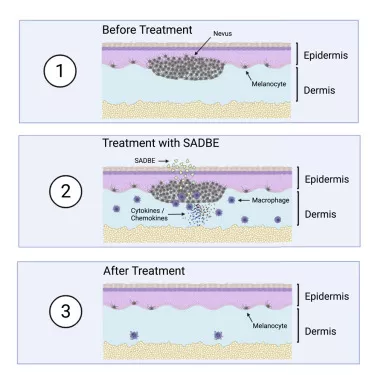Skin cancer is the most common type of cancer in the United States. About 9500 people in the United States are diagnosed with skin cancer every day. Skin cancer is divided into three types: basal cell carcinoma, squamous cell carcinoma and melanoma. Melanoma is the deadliest form of skin cancer. It develops in cells that produce melanin, the pigment that gives skin color.
Although the exact cause of all melanoma is unknown, exposure to ultraviolet radiation, whether from sunlight or elsewhere, increases the risk of melanoma. In addition, people with many moles or abnormal moles are more likely to develop skin cancer.

One in every 20000 newborns has congenital giant nevus, a large pigmented nevus that covers most of the face and body. Due to the appearance of the nevus and the possibility that it may become skin cancer in the future, many parents choose to let their children undergo major surgery to remove the entire lesion, which may lead to huge and permanent scars. Researchers at Massachusetts General Hospital (MGH) have developed several preclinical models of this condition and used these models to demonstrate that applying several ointments to the skin can make the lesions shrink. One of the topical drugs can also prevent skin cancer. Their results were published in the journal Cell on may12,2022.
Dr. David E. Fisher, senior author, director of melanoma program of MGH cancer center and director of MGH skin biology research center, said: "the goal of our research is to develop a series of animal models to clarify the key biological characteristics of these lesions and test the non-manual drug treatment of the skin. The purpose is to make the nevus cells disappear, so as to eliminate the need for surgical treatment."
These models include modified mice expressing a gene called NRAS, which contains a mutation known to cause congenital giant nevi in most people, and mice transplanted with skin grafts containing human congenital giant nevi. Fisher and his colleagues used these models to examine the various stages of these moles in order to better understand their origin and development. In addition, when the scientists used these animals to evaluate the local application of single or combined drugs that inhibit the signal pathways known to be caused by NRAS mutations, they found that some of these treatments resulted in significant regression of nevus. In addition, after three treatments with a drug that causes an inflammatory reaction after local administration to the skin, the nevus completely subsided. The treatment also provided complete protection against the formation of skin cancer in mice.
"These findings will hopefully lay the foundation for additional improvements in such skin treatments aimed at directly testing patients with congenital giant nevi," Fisher said. "This work will include additional studies on safety, potential further enhancement of efficacy, and more analysis of potential mechanisms. The overall goal is to prevent melanoma in these patients while avoiding the disfigurement challenges posed by these lesions.".
Learn more:
https://www.cell.com/cell/fulltext/S0092-8674(22)00472-X?_returnURL=https%3A%2F%2Flinkinghub.elsevier.com%2Fretrieve%2Fpii%2FS009286742200472X%3Fshowall%3Dtrue00472-X?_returnURL=https%3A%2F%2Flinkinghub.elsevier.com%2Fretrieve%2Fpii%2FS009286742200472X%3Fshowall%3Dtrue)